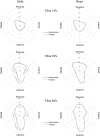Influence of a School-based Physical Activity Intervention on Cortical Bone Mass Distribution: A 7-year Intervention Study
- PMID: 27406102
- PMCID: PMC5055572
- DOI: 10.1007/s00223-016-0174-y
Influence of a School-based Physical Activity Intervention on Cortical Bone Mass Distribution: A 7-year Intervention Study
Abstract
Cortical bone mass and density varies across a bones length and cross section, and may be influenced by physical activity. This study evaluated the long-term effects of a pediatric school-based physical activity intervention on tibial cortical bone mass distribution. A total of 170 children (72 girls and 98 boys) from one school were provided with 200 min of physical education per week. Three other schools (44 girls and 47 boys) continued with the standard 60 min per week. Tibial total and cortical area, cortical density, polar stress-strain index (SSI), and the mass and density distribution around the center of mass (polar distribution, mg) and through the bones cortex (radial distribution subdivided into endo-, mid-, and pericortical volumetric BMD: mg/cm3) at three sites (14, 38, and 66 %) were assessed using peripheral quantitative computed tomography after 7 years. Girls in the intervention group had 2.5 % greater cortical thickness and 6.9 % greater SSI at the 66 % tibia, which was accompanied by significantly greater pericortical volumetric BMD compared to controls (all P < 0.05). Region-specific differences in cortical mass were also detected in the anterior, medial, and lateral sectors at the 38 and 66 % tibial sites. There were no group differences at the 14 % tibia site in girls, and no group differences in any of the bone parameters in boys. Additional school-based physical education over seven years was associated with greater tibial structure, strength, and region-specific adaptations in cortical bone mass and density distribution in girls, but not in boys.
Keywords: Bone distribution; Children; Physical activity; pQCT.
Conflict of interest statement
Compliance with Ethical StandardsConflict of InterestJesper Fritz, Rachel L Duckham, Timo Rantalainen, Björn E. Rosengren, Magnus K Karlsson, and Robin M Daly declare that they have no conflict of interest to disclose. The authors have full control of all primary data and agree to allow the journal to review the data if requested.Human and Animal Rights and Informed Consent StatementsInformed consent was obtained from all parents and participating children prior to the commencement of the study. The study was approved by the ethics committee of Lund University, conducted according to the Declaration of Helsinki and was registered as a clinical trial (ClinicalTrials.gov.NCT00633828).
Figures



Similar articles
-
Effects of Habitual Physical Activity and Fitness on Tibial Cortical Bone Mass, Structure and Mass Distribution in Pre-pubertal Boys and Girls: The Look Study.Calcif Tissue Int. 2016 Jul;99(1):56-65. doi: 10.1007/s00223-016-0128-4. Epub 2016 Mar 16. Calcif Tissue Int. 2016. PMID: 26983726
-
A 5-year exercise program in pre- and peripubertal children improves bone mass and bone size without affecting fracture risk.Calcif Tissue Int. 2013 Apr;92(4):385-93. doi: 10.1007/s00223-012-9691-5. Epub 2013 Jan 22. Calcif Tissue Int. 2013. PMID: 23338815 Clinical Trial.
-
Effects of a Specialist-Led, School Physical Education Program on Bone Mass, Structure, and Strength in Primary School Children: A 4-Year Cluster Randomized Controlled Trial.J Bone Miner Res. 2016 Feb;31(2):289-98. doi: 10.1002/jbmr.2688. Epub 2015 Sep 3. J Bone Miner Res. 2016. PMID: 26260216 Clinical Trial.
-
[Daily school physical activity increases bone mass and gradually reduce the fracture risk].Lakartidningen. 2019 Mar 19;116:FHP7. Lakartidningen. 2019. PMID: 31192412 Review. Swedish.
-
Growth of cortical bone thickness and trabecular bone density in Japanese children.Bone. 2020 Dec;141:115669. doi: 10.1016/j.bone.2020.115669. Epub 2020 Oct 3. Bone. 2020. PMID: 33022454 Review.
Cited by
-
Sex differences in the associations of physical activity and macronutrient intake with child body composition: A cross-sectional study of 3- to 7-year-olds in Samoa.Pediatr Obes. 2020 Apr;15(4):e12603. doi: 10.1111/ijpo.12603. Epub 2020 Jan 10. Pediatr Obes. 2020. PMID: 31925928 Free PMC article.
-
Exercise and Peak Bone Mass.Curr Osteoporos Rep. 2020 Jun;18(3):285-290. doi: 10.1007/s11914-020-00588-1. Curr Osteoporos Rep. 2020. PMID: 32249382 Free PMC article. Review.
-
Peripheral quantitative computed tomography (pQCT) for the assessment of bone strength in most of bone affecting conditions in developmental age: a review.Ital J Pediatr. 2016 Sep 26;42(1):88. doi: 10.1186/s13052-016-0297-9. Ital J Pediatr. 2016. PMID: 27670687 Free PMC article. Review.
-
Is it important to achieve physical activity recommendations at early stages of life to improve bone health?Osteoporos Int. 2022 May;33(5):1017-1026. doi: 10.1007/s00198-021-06256-z. Epub 2021 Dec 14. Osteoporos Int. 2022. PMID: 34905063 Free PMC article.
-
Daily School Physical Activity from Before to After Puberty Improves Bone Mass and a Musculoskeletal Composite Risk Score for Fracture.Sports (Basel). 2020 Mar 28;8(4):40. doi: 10.3390/sports8040040. Sports (Basel). 2020. PMID: 32231105 Free PMC article.
References
-
- Gunter K, Baxter-Jones AD, Mirwald RL, Almstedt H, Fuller A, Durski S, Snow C. Jump starting skeletal health: a 4-year longitudinal study assessing the effects of jumping on skeletal development in pre and circum pubertal children. Bone. 2008;42:710–718. doi: 10.1016/j.bone.2008.01.002. - DOI - PubMed
Publication types
MeSH terms
LinkOut - more resources
Full Text Sources
Other Literature Sources
Medical

